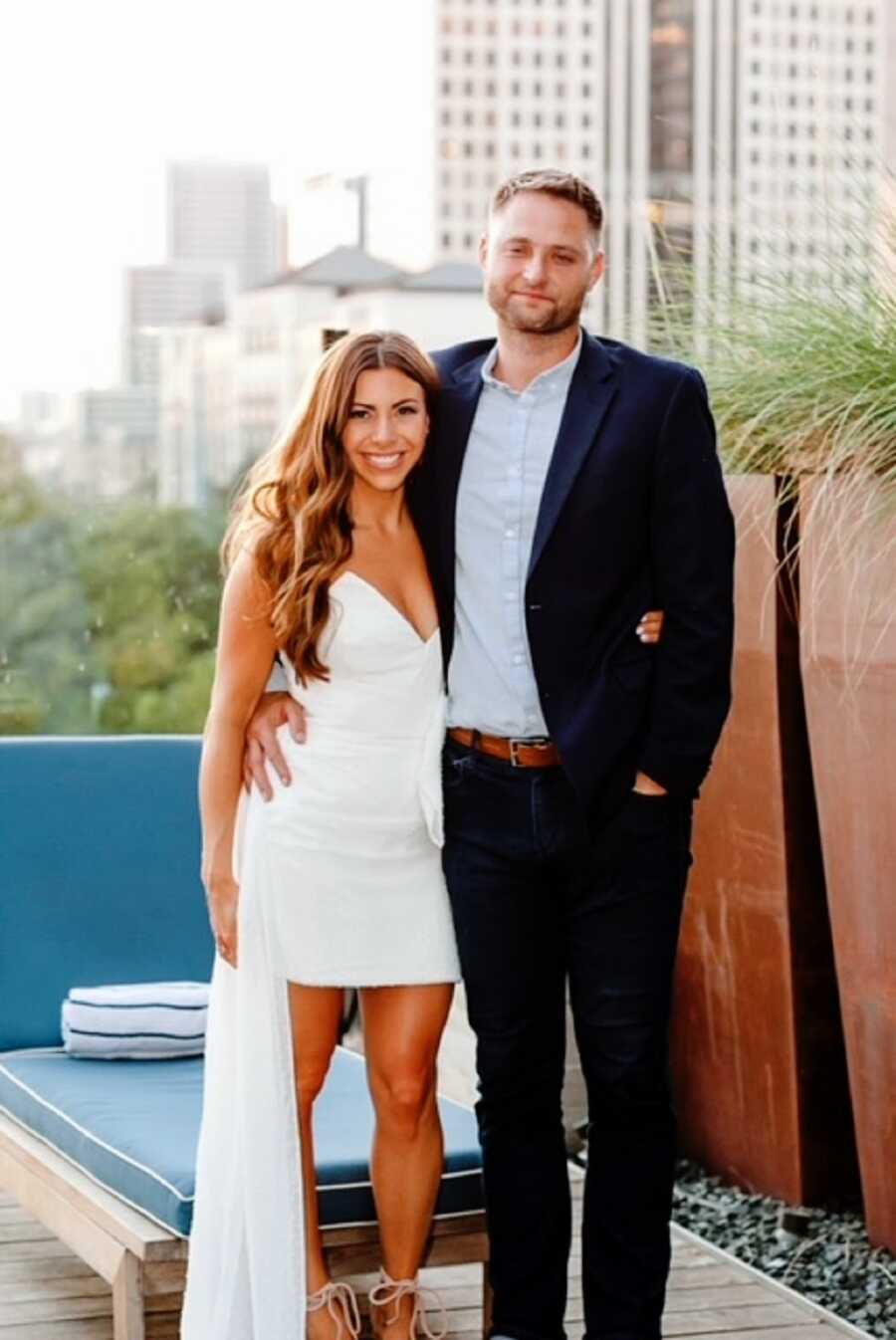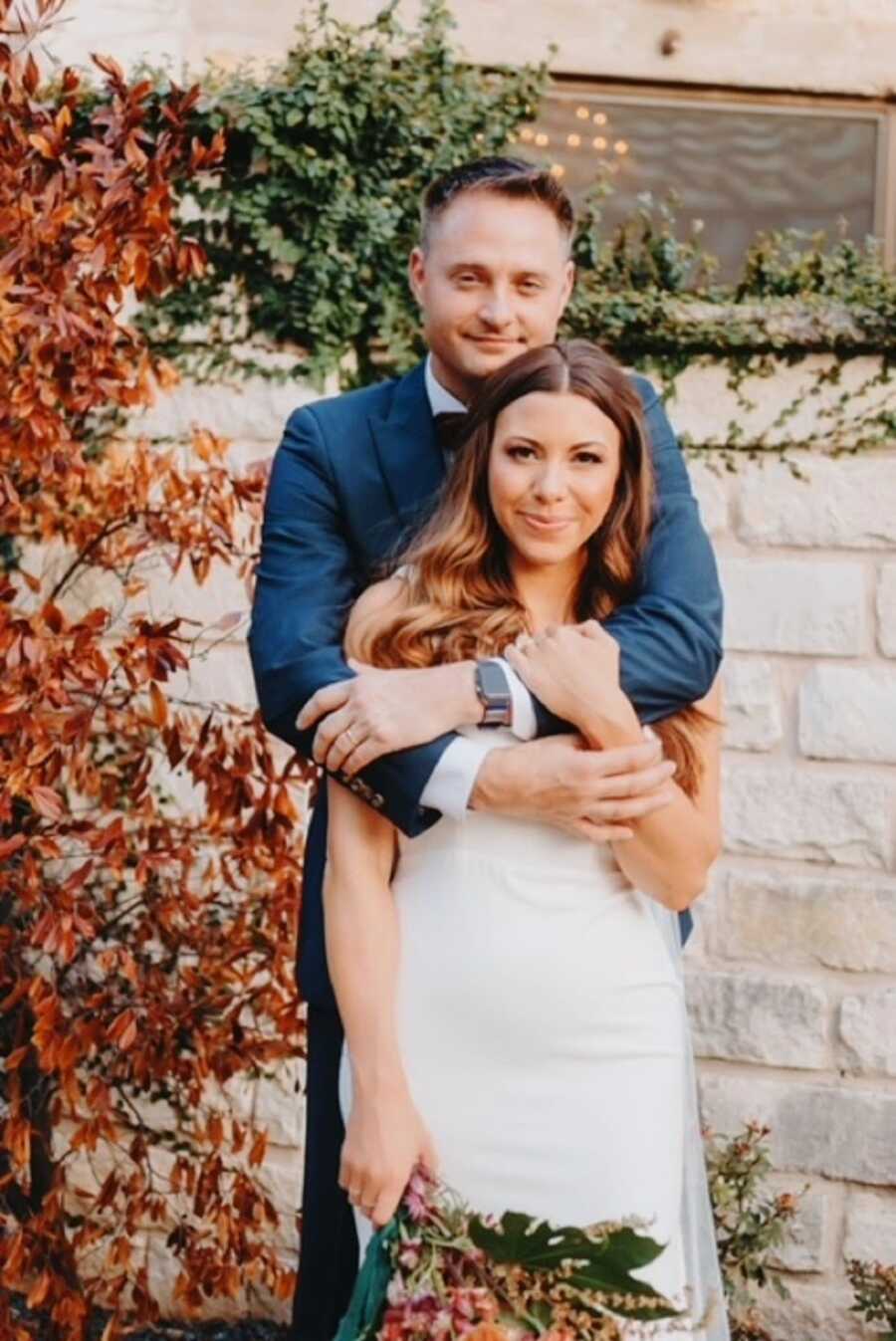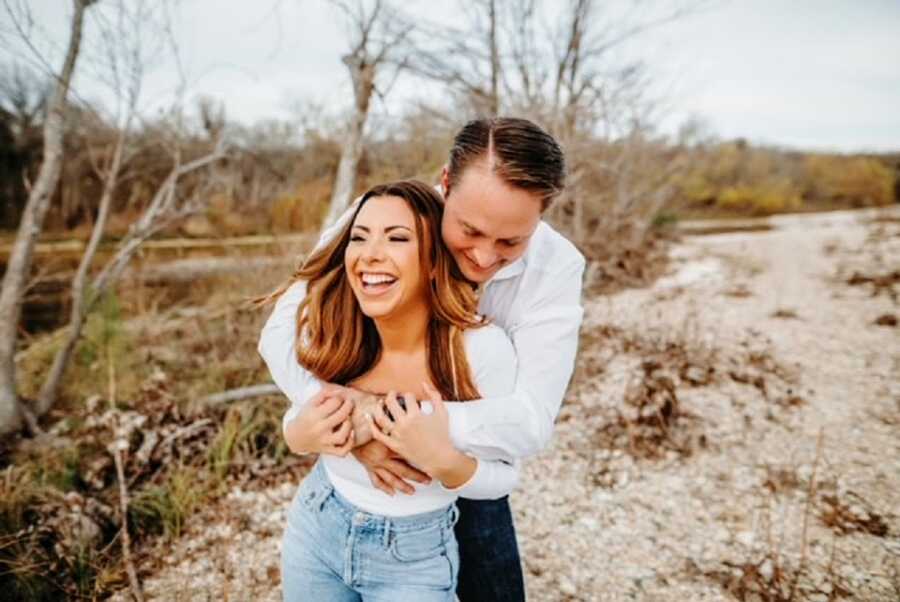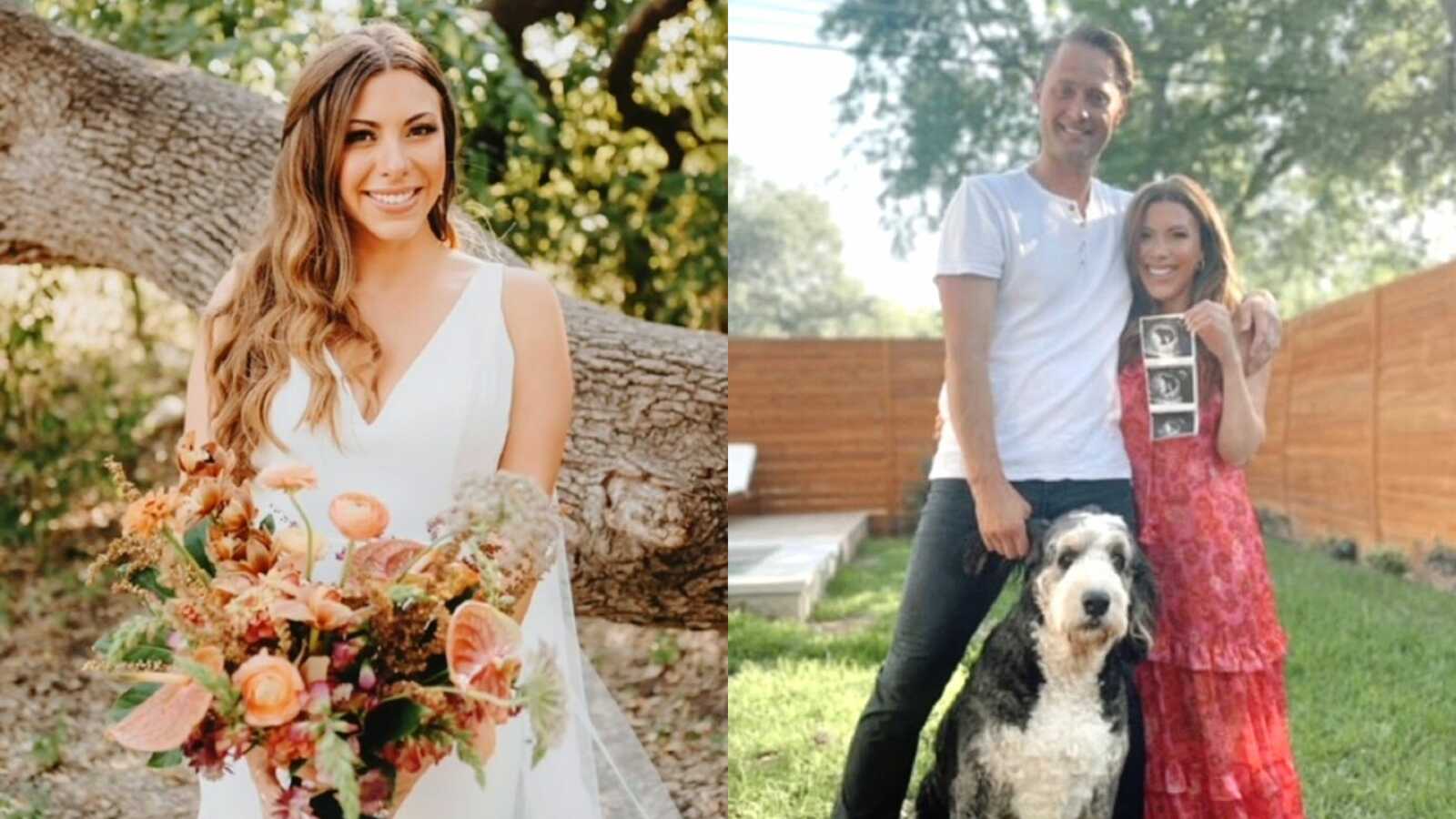Disclaimer: This story includes details of miscarriage that may be triggering for some.
“I know how triggering pregnancy announcements can be for families out there trying to conceive. I was one of those for a very long time and still am a part of that club. I’m going to get super vulnerable here as I want this to be something people discuss more and also hopefully be able to help any of you who may be experiencing the same thing.

Infertility and Heartbreak
This has been a two-year journey for us. I’ve experienced miscarriage. I’ve experienced unexplained infertility. I’ve been through 4 rounds of IUI all failed. I’ve been to multiple fertility doctors. I’ve been diagnosed with PCOS. I’ve read all the things, done all the tests, been poked and prodded. I’ve shoved countless shots into my body. I’ve been through IVF. I’ve had a failed IVF transfer, and it felt just as devastating as my miscarriage.
I had all my friends having kids around me easily, having mom get-togethers I wasn’t privy to, attending and supporting everyone’s baby showers and kids’ birthdays being asked, ‘When are y’all having kids?!’ I’ve been broken over and over. I want you to know, if you’re going through this, you’re not alone. I’ve been there.
A palm reader once told me in my life, I would have to work harder than other people. Things that should take 1 year, will take 3 or 4 or 5. That tends to ring true for me. In March 2020, I lost my father, one day after we rescheduled our wedding that was supposed to be on his birthday, May 30. In the next few months, I went on to lose two grandfathers, my grandmother who had a stroke during my father’s funeral, my uncle, and then ending on my miscarriage in October. Since then it has been a 2-year journey of infertility and heartbreak.

A Devastating Miscarriage
We got married in August 2020 and immediately started trying to get pregnant. I started using ovulation strips, and by September, I already had a positive pregnancy test. I went to my first appointment at what was estimated to be 7 weeks. At the first appointment, my doctor could not hear a heartbeat but thought she saw the flicker of one on the sonogram. She assured me since I didn’t ovulate until very late in my cycle, I must only be about 5 weeks pregnant, and that is too early to actually hear a heartbeat. She scheduled me to come back in 2 weeks. During that time, we had a trip to Dallas for my mom’s 60th birthday, and we told the whole family we were pregnant, including sharing the sonogram photo the doctor had given to us. We were over the moon we were able to get pregnant so quickly, especially after seeing so many friends struggle with infertility.

The Monday after getting home from Dallas, we had our 8-week appointment. My husband wasn’t allowed to come into the room with me the first time, since this was still the peak of Covid in 2020—so this time, he didn’t come with me to the appointment, as we assumed everything would be fine. The doctor started the sonogram and broke the news to me that there was no heartbeat, and the baby had not grown since my last appointment, confirming this was not a viable pregnancy. I sobbed and sobbed. She told me over and over this was not my fault, it was nothing I did wrong: miscarriages happen in 1 in every 4 women. I was actually shocked to hear that, as I didn’t know the statistic was that high.
She then explained to me the two options for passing the fetus. One was to take the abortion pill, which was her recommended method as it is less invasive and you can pass it at home. The other was to do a D&C, which she didn’t recommend unless the pill didn’t work for some reason. D&C’s can cause scarring in your uterus which can affect future pregnancies. We were prescribed the pill, and I went home to be with my husband. We sobbed and sobbed together, devastated and confused as to why this was happening to us.
We picked up the pill that afternoon. It was October 12, 2020—a day that will be ingrained in my mind forever. We were told by the doctor it would just be like heavy period cramps. It was much, much more than that. You insert the pill vaginally, lie there for an hour, and about 2 hours after taking it you are in extreme pain. I was vomiting, had diarrhea, and couldn’t move from the fetal position. My husband carried me from the bed to the toilet to the shower where I let warm water beat down on my stomach to help ease the pain. Then back to bed again, and did this over and over for about 4 hours. It was an out-of-body experience. I finally fell asleep from the pain and woke up feeling like I had been hit by a bus. I would never, ever wish this upon anyone.

Fertility Treatments
After our miscarriage, we were told since we got pregnant so quickly the first time, we would be even more fertile the next 6 months after a miscarriage. My doctor set up an appointment for me to visit after 6 months and check in. It took about 2 months after the miscarriage for my period to start. From there, I tracked my ovulation on ovulation strips and used the Easy At Home app to take photos of them throughout each month. This came in handy to be able to show my doctor.
After 6 months of naturally trying and having no success, I chatted with my OB about next steps. I knew I wanted to go straight into IUI and not wait. She looked at my ovulation strips and determined I was not ovulating regularly—my strips would peak multiple times throughout the month, where normally they should only peak once, when you ovulate. She assured me it was okay, with IUI the medication would help me to ovulate.

For IUI, you are essentially just taking an ovulation induction medication (like Clomid or Letrozole), to force your body to produce an egg. You take these from day 3 through day 7 of your cycle, and then my doctor had me come in on day 12 and see if an egg had grown. From there, they will take a sperm sample, ‘clean’ the sperm (making sure it is only correctly formed sperm, swimming in the right direction, etc.), and ‘turkey baste’ it into you vaginally via a catheter. This isn’t painful, you just feel slight pressure. You wait until your period starts or don’t know if it took or not.
They start you on a low dosage of OI meds at first because they don’t know how your body will react. For me, I started with 1 pill per day for the first month and didn’t produce an egg. Moved up to 2 pills per day the 2nd month, produced an egg, moved forward with sperm transfer, and it didn’t take. Stuck with 2 pills per day for the 3rd month, and did not produce an egg. Finally, after the 3rd month of it not working, my doctor recommended I see a fertility specialist.

A Surprising Diagnosis
It took a few weeks to get into a fertility specialist. I also wanted to go with one that took my insurance as my company did provide some coverage. At the first appointment, the doctor took one look at my egg reserve (AMH) and my lack of ovulation and determined I have PCOS. There isn’t a test for PCOS unfortunately, so it takes doctors looking at several things to determine if you have it. PCOS stands for Polycystic Ovarian Syndrome, but it doesn’t necessarily mean you have a ton of cysts. The primary issue with PCOS patients is irregular ovulation, which makes it challenging to naturally get pregnant.
I also learned women with PCOS have about 3x the normal risk for miscarriage. The normal risk for miscarriage is about 10-15% in non-PCOS women. PCOS women are about 30-45%. This explained my miscarriage partially. I ended up moving forward with one final round of IUI with my OB, because we hadn’t yet tried IUI with the max dosage of 3 pills per day, and I just wanted to see if it would work. I produced 1 egg again, and alas, it did not work.

Egg Retrieval
At this point, we were moving forward with an egg retrieval. You inject shots into your stomach for 10-12 days to grow a good amount of eggs. Then during the retrieval, you are put under, the procedure is about 30 minutes, and they insert a catheter vaginally to extract the eggs from your ovaries. One bright side for PCOS patients is they tend to have a high egg reserve because you don’t ovulate regularly and release the eggs. Our egg retrieval went smoothly, and we got plenty of eggs and ended up with a good amount of genetically normal embryos. I know this is not the case for many women, who have to go through several rounds of egg retrievals. One thing that also happens a lot with PCOS patients post-retrieval, is to get something called OHSS, which I did end up getting a mild case of.
It is Ovarian Hyperstimulation Syndrome, and if you produce more than 20 eggs it is kind of bound to happen. It just makes your recovery a little more uncomfortable with lots of cramping and bloating. Overall, the retrieval process as a whole is about 3 weeks long. Once the eggs are retrieved, they mix each egg in a petri dish with the sperm, see how many hatch in the first 24 hours, and then allow them to grow for 5 days into an embryo. From there, they biopsy the exterior layer of cells surrounding the outside edge of the petri dish, freeze the embryos, and send off the biopsied cells for genetic testing which takes about 2 weeks. You will lose some eggs after each round—how many hatch, how many turn into embryos, how many come back genetically normal.
Once you have your genetically tested eggs, you are ready for embryo transfer. This only takes about 5 minutes, you’re awake, and they insert the egg vaginally through a catheter. There are various medical protocols in preparation for a transfer. The first one we tried was a more ‘natural’ cycle, where I took some of the same OI meds I took during IUI and the egg retrieval, to help eggs grow, then do a trigger shot to release the egg, which triggers your lining to get thicker in preparation to receive an embryo to implant into your uterine lining. This would mimic a more normal cycle of what your body would naturally do when creating a baby. This first round and transfer unfortunately did not work for us, and it was completely devastating.
Unfortunately, sometimes the transfer part is trial and error, and they are figuring out which type of medical protocol will work for you. The next round I did a higher medication transfer cycle where they want your ovaries to be sleepy, not producing eggs, and you are taking a combination of progesterone and estrogen to build up your uterine lining to at least a 7mm-10mm. After 9 days, the doctor will have you come in for a blood test to test your HCG levels and determine if you are pregnant. Once this is confirmed, they will have you come back 48 hours later to see if the HCG has doubled, which would indicate the baby is continuing to grow.
We FINALLY had this second transfer result in pregnancy. We then had ultrasounds at our fertility specialist at weeks 6, 7, and 8, and graduated to our OBGYN at 10 weeks. You are also on progesterone (either shots or suppositories) for those first 10 weeks to help IVF patients maintain a healthy progesterone level needed for the baby.

Choosing Myself
Our story was long and painful. I couldn’t understand what the world was trying to teach me, why I’d experienced so much loss and grief in the last few years. To learn strength, maybe? I’m not sure I had a choice. You just have to get up every single day and try to move forward. Some days you can, some days you lay in bed all day mourning. As many women do, I suffered in silence. I felt like no one could understand. There were very few people I felt comfortable opening up to. It was too hard to subject myself to comments that were triggering or unintentionally hurtful.
I’m not perfect. I try to eat all the right things and do all the workouts and rest and take vitamins and go to therapy. But some days just doing the bare minimum means it’s a good day and that’s good enough for me. I had to choose myself. I am not the same person I was when my journey began. I had to distance myself from certain friendships that didn’t provide great energy for my mental health. Some understood, some didn’t, and some relationships ended. People had to make my journey about themselves. I chose to remove negative, draining, and unhealthy energy from my life and protect my mental health, or I was not going to survive this. It was debilitating.

I had to make big changes to my life. I had to wake up and choose myself every day or I wasn’t going to be able to anymore. I searched for answers in a million places. Multiple fertility doctors, fertility tests, therapists and EMDR, food sensitivity tests, stopped eating dairy, homeopathic doctors, looking at all the ingredients on everything I consumed/used, stopped drinking alcohol and coffee, acupuncture, meditation, reading, journaling, tarot readers, astrologists, mediums, psychics – literally everywhere.
After every single devastation you can’t help but wonder, what is the world trying to teach me? When is enough, enough? The worst part was there were never really any answers as to why each round of treatment wasn’t working. I found myself constantly in the ‘unexplained’ category, which would never sit well with me.
It was always just:
‘Not this time, but you can try again.’
‘Not this month of naturally trying, but after 6 months you can try IUI.’
‘Not this month of IUI but you’ve done it 4x now so you can graduate to IVF.’
‘Not this round of IVF but you can keep using more embryos and try again.’

Toxic Positivity
Just because you can try again, doesn’t mean every single month of loss and grief doesn’t hurt. It doesn’t mean every single time it doesn’t hurt worse. It doesn’t mean the questions about ‘how it’s going’ or ‘when are you having kids’ or ‘what’s the problem’ stops.
Listening to everyone’s toxic positivity responses or problem-solving, was devastating.
‘At least you have your husband!’
‘Be grateful for the life you have!’
‘At least you know you can get pregnant, you got pregnant before!’ (miscarriage)
The term ‘at least.’
I know people mean well, but sometimes it’s best to just listen vs try to problem-solve or get the person to look on the bright side of a heartbreaking situation. It invalidates their feelings. I had constant social anxiety about going somewhere and someone asking me about it – it was easier just to not go, and a lot of times people didn’t understand and would give me a hard time, which would make it worse.
I couldn’t understand. I couldn’t understand why the world picked me to be a part of this club and why there are unfortunately so many members. I couldn’t understand why this was my journey and it was so easy for everyone else. I couldn’t understand why my body over and over again could not carry a baby successfully. But now, it’s a part of my story and something that was an eye-opening experience in my life.
Infertility is a devastating thing to go through. There are just still not a ton of answers. You just have to keep trying, keep spending more and more of your time and money to get there. Unfortunately, some people don’t have enough of either to be able to start a family these days. I actually consider myself lucky to have the access to the treatments we’ve tried.
I am so happy to say after 2 years, we are finally pregnant, and expecting a baby girl in November 2022. I wanted to share my journey with the world as I had no idea what infertility looked like, felt like, and how many it affects. It is so important to share and let others know they are not alone.”

This story was submitted to Love What Matters by Erin Kee of Austin, TX. You can follow her journey on Instagram and her website. Submit your own story here, and be sure to subscribe to our free email newsletter for our best stories, and YouTube for our best videos.
Read more stories like this:
Why Infertility Has Changed Me Forever
There Is No Perfect Way To Handle Infertility
Do you know someone struggling with infertility? Please SHARE this story on Facebook to help give them hope that miracles can and do happen.




